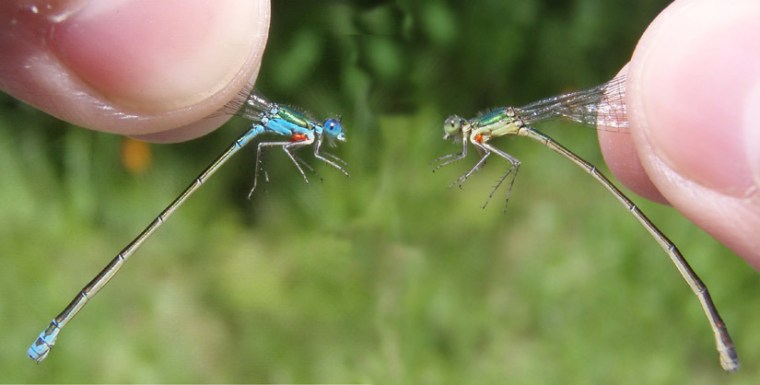Females that bear a striking resemblance to males within their same species are, in some cases, evolving ever-more masculine bodies and behaviors, suggests a new study that may help to explain how mimicry among animals and insects works.
Nature's transvestism occurs in a diverse array of species, from female hyenas with pseudo penises to butch butterflies. The phenomenon is particularly evident in damselflies, where certain females, called andromorphs, are often more dude than damsel.
"Males recognize and treat male-like females indeed as other males, thus sometimes andromorphs are being ignored (sexually)," Arne Iserbyt, lead author of the study, told Discovery News. "In addition to looking like males — same body coloration, abdomen pattern and morphology — these male-like females can show quite aggressive and typical male-like refusal behavior towards approaching males."
Iserbyt, a researcher in the Evolutionary Ecology Group at the University of Antwerp, joined forces with colleagues at his university as well as at Carleton University and the University of Toronto, to study the damselfly species Nehalennia irene.
For the study, published in the latest issue of the Proceedings of the Royal Society B, Iserbyt and his team looked at 1,296 of these damselflies in six different populations. About one-third of the insects were male-like females, while the others were males and females that bore little resemblance to the males.
The researchers determined that in damselfly populations with a high ratio of andromorphs to males, these females evolved more masculine features. In other words, their mimicry improved as their numbers increased relative to the amount of males.
The reason why this probably happens is tied to the strategy behind the mimicry itself. Damselfly mating generally involves a fair amount of female harassment that females understandably try to avoid. Acting like "one of the boys" offers the insects an easy way out.
"Indeed, males may become confused when facing multiple female morphs," Iserbyt said. "The male-like females have an extra advantage here. This is because males are able to learn from prior encounters. And since useless male-male interactions frequently happen, they try to avoid other males and anything that resembles them, including male-like females."
The more male-like females these males encounter, however, the greater the likelihood that these two types will mate. The andromorphs therefore continue to evolve increasingly male characteristics. The researchers believe this pattern could hold true for other insects and animals with individuals that mimic members of their own species.
The process in this case is driven, not by natural selection (predation pressure), but by sexual selection.
Although the male-like females have an overall lower birth rate than other females, they do still mate and reproduce, maintaining the mimicry in the damselfly population.
Mark Forbes, associate vice president of research at Carleton University, told Discovery News that the new study "is a detailed and unique examination of a key prediction" derived from mathematical models. Forbes said he was surprised that it hadn't been tested before on an organism with intraspecific mimicry.
Adolfo Cordero Rivera, a scientist in the ECOEVO Group at the University of Vigo, told Discovery News that certain male-like female damselflies in other species he's studied so closely resemble males that sometimes pictures of these butch females "appear in books as examples of males."
Cordero Rivera agreed the new data supports that when female-like males are common relative to males, their mimicry of the males improves.
"Now we need several more studies in other species and ecological circumstances," he said, to see if the detected pattern really does hold true, as the researchers suspect, for animals and insects other than damselflies.
